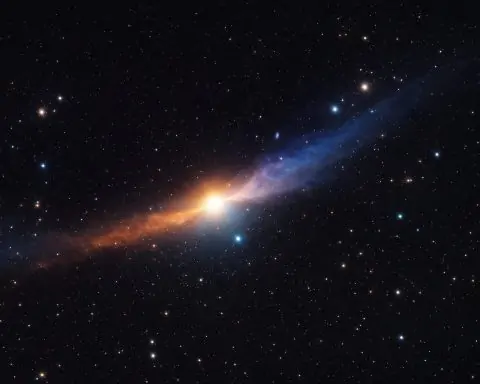- Intense geomagnetic storm: NOAA’s Space Weather Prediction Center warns a G3 (“strong”) geomagnetic storm on Sept 30 (lasting into the morning of Oct 1) due to a CME from recent solar flares [1]. (An M6.4-class X-ray flare on Sept 29 triggered an R2 radio blackout [2].) This storm could spark dramatic aurora displays at high latitudes.
- Visible comets: Two comets are on the rise. C/2025 R2 (SWAN) was discovered Sept 12 by NASA’s SDO satellite; it’s now at ~mag 6–7 (barely naked-eye) and “is barely visible to the eye. But binoculars will show it!” [3]. By Oct 21 it may brighten to mag ~4 (naked-eye) [4]. Also, C/2025 K1 (ATLAS) is brightening ahead of its Oct 8 perihelion (predicted ~mag 7.5) [5] – possibly visible in binoculars in Virgo later this month.
- Planets and Moon:Saturn is prominent (opposition was Sept 21) and “is still visible nearly all night” [6]. Jupiter and Venus grace the pre-dawn eastern sky (Venus very low before sunrise) [7]. Mars hangs low in the west at twilight. On Oct 1, a waxing gibbous Moon will rise in the south, near the stars of Capricornus [8] (use it as a guide). Later, the Harvest/Super Moon (Oct 6–7) will illuminate evenings.
- Meteor activity: No major shower peaks exactly Sept 30–Oct 1, but the Southern Taurids (Sept–Nov) are active (though weak – ~2/hr at best) [9]. The minor Daytime Sextantids peak on Oct 1 (radiant in Sextans near the Sun) [10] – mostly a radar shower, so not easily seen. Look ahead to Oct 8–9 for the Draconid shower (a few meteors/hour under dark skies); note EarthSky’s tip: “try blotting out the moon – behind a tree, a barn, or a mountain – when watching for meteors” [11]. The Orionids run Oct 2–Nov 7 (peak Oct 21–22, with a new moon) and will be strong. Sporadic meteors (~5–10 per hour) are possible late night if skies are clear.
- Aurora watch: NOAA’s SWPC says the strong geomagnetic storm on Sept 30 could cause powerful northern lights at high latitudes [12]. After midnight on Sept 30–Oct 1, even mid-latitudes might catch glimmers of aurora. (Check NOAA/SWPC dashboards or apps for real-time KP indices.)
- Satellites & ISS: Bright ISS flyovers are routine; skywatchers should check NASA’s “Spot the Station” or local tracking sites for upcoming visible passes on the evenings of Sept 30 and Oct 1. Many satellites and the ISS will be illuminated after sunset – binoculars or telescopes can bring them into focus.
- Weather & visibility: The Moon sets around midnight on Sept 30/Oct 1, leaving late-night skies darker for the few hours before dawn. However, October sees more clouds and rain in many regions, so local forecasts are crucial. Observers should seek clear, dry conditions (and minimal light pollution) for the best views. Dressing warmly and arriving a bit early for your target event are good practices.
Space Weather & Aurora Forecast
NOAA forecasts a Strong (G3) geomagnetic storm on Sept 30, 2025. According to SWPC, “G3 (Strong) geomagnetic storming is expected through 30/1200 UTC due to CME influences” [13]. This follows an M6.4-class solar flare on Sept 29 (from active Region 4232), which caused an R2-level radio blackout [14]. Aurora experts note that such storms can power dazzling Northern Lights. The peak storming late Sept 30 (early Oct 1 UT) means northern skies may glow. “Quiet to active” conditions are forecast after the storm, so Sept 30 is the prime aurora night. (Skywatchers should watch real-time SWPC alerts or aurora apps around 30 Sept.)
“We may see G3-level storming on Sept 30,” says SWPC – meaning strong aurora is possible at high latitudes [15]. Mid-latitude observers should stay alert after midnight on Sept 30. If the sky is clear, keep an eye on the northern horizon for green, red or purple glows.
Planets, Moon & Constellations
Evening planets: Mars is visible in the west after sunset. Saturn, having reached opposition on Sept 21, is now bright in the east at dusk and remains above the horizon all night [16]. Its rings are nearly open to view. Look SSE to see Saturn climbing after sunset.
Morning planets: In the pre-dawn sky, two bright planets dominate. Venus rises in the east about 2–3 hours before sunrise, very low on the horizon, while Jupiter rises around midnight and climbs higher by dawn [17]. “As seen from around the globe, Venus will lie low in the east, and Jupiter will shine higher in the morning sky” [18]. Both will be brilliant, with Venus slightly brighter. Jupiter’s moons may be visible in binoculars. Saturn, in contrast, will stay visible until sunrise.
The Moon: On Oct 1, the waxing gibbous Moon will appear in the south after sunset, near the stars of Capricornus [19]. (EarthSky notes it “will hang in the south near the constellation Capricornus the Sea-goat” on that evening [20].) However, be aware that the bright Moon will wash out faint deep-sky targets. By Oct 2 the Moon enters Pisces. Later in the week, the Oct 6 Full Moon (the Harvest/Super Moon) will glow nearly all night, just south of Saturn [21].
Other sights: The zodiacal light (a faint triangular glow along the ecliptic) is often visible around equinox. EarthSky points out that “the zodiacal light might be visible before morning twilight for Northern Hemisphere observers in dark skies around the September equinox” [22]. So on late Sept and early Oct mornings (before twilight), face east to look for this “false dawn” glimmer.
Meteor Showers & Shooting Stars
While no major shower peaks exactly on Sept 30/Oct 1, a few minor streams and sporadics are of note:
- Southern Taurids: Active roughly Sept 20–Nov 20 [23]. Rates are low (a couple meteors per hour), but Taurids include many fireballs. The shower’s radiant is in western Taurus (near the Pleiades). These are slow meteors (31 km/s), so watch high in the sky after midnight. The Taurids have two weak peaks (mid-Oct and early Nov) [24], but any Taurids now are a bonus.
- Daytime Sextantids (DSX): Active Sept 22–Oct 13, peaking Oct 1 [25]. However, their radiant lies near the Sun, so they are mostly invisible to the eye (observed by radar/radio). We mention them for completeness: a handful of meteors might appear just at dawn if you face east, but count on them being rare.
- Draconids (Oct 8–9): Coming next week, with peak around Oct 8 (after dark). This year the Draconids will be at a disadvantage from moonlight. “It’s not the best year for the Draconids, because a thick waning gibbous will light up the sky,” EarthSky warns [26]. Under moonlit skies you might only see a few per hour. EarthSky’s handy tip: “try blotting out the moon – behind a tree, a barn, or a mountain – when watching for meteors” [27]. The radiant is near Draco’s head, high in the northwest at nightfall, so face that direction.
- Orionids (Oct 2–Nov 7): Although the Orionid peak is mid-October (Oct 21–22), the shower is already active from early Oct. With the New Moon on Oct 21, conditions will be ideal then. Until mid-October, only sporadics and stray shower members appear.
Tip: The first quarter Moon on Sept 29 (rising around noon, setting by midnight) means the sky is darkest late at night on Sept 30/Oct 1. Plan any meteor watching for after midnight, once moonlight has faded (or hide it behind an obstacle). Under dark rural skies, you might catch a handful of sporadic meteors per hour.
Comets and Minor Planets
- Comet SWAN (C/2025 R2): This long-period comet is currently low in the western twilight (just above the sunset glow), about halfway between Mars and the star Zubenelgenubi [28]. It was recently at +6th–7th magnitude; astronomers predict it could brighten to ~mag 4 by mid-October [29]. If so, SWAN R2 could become a naked-eye fuzzy (in very dark skies), though binoculars will certainly show it. “A new comet, C/2025 R2 (SWAN), is barely visible to the eye. But binoculars will show it!” [30]. By early October, face west-southwest soon after sunset to seek it. (It spends most of September low to the horizon from northern latitudes.)
- Comet ATLAS (C/2025 K1): Discovered May 2025, this comet is rapidly brightening as it approaches perihelion on Oct 8. It may reach ~mag 7–8 by that time, so visible in good binoculars [31]. It lies in Ophiuchus/Scorpius late Sept, then moves toward Sagittarius in early Oct. Try pointing binoculars roughly in the southern sky just after dusk.
- Ceres at opposition: On Oct 2, dwarf planet Ceres is in opposition (closest to Earth and fully illuminated). Space.com notes it will reach mag 7.65, making it a decent binocular target [32]. Ceres will be located in Cetus near the star Eta Ceti (Deneb Kaitos). Telescopes may resolve its disk; binoculars will see a tiny dot.
In summary, skywatchers should look west after sunset for comets SWAN and ATLAS (and Mercury by late Sept, low in southwest), and face east before dawn for the bright planets (Venus/Jupiter) and any aurora glows. Saturn sits in the southeast night sky.
Satellites, ISS & Other Sights
The International Space Station makes regular visible passes. Around Sept 30–Oct 1, check NASA’s SpotTheStation (or apps) for local flyover times. Several bright glows will cross the sky 2–3 times per night, moving swiftly from W to E. Don’t confuse the station with Iridium flares or Starlink trains (which can also be bright). Binoculars or a small telescope make these satellites even more impressive.
If aurora do appear, observers should try to document with long-exposure photography (swung camera or static tripod) since visually they can be dim except near the poles.
Weather and Viewing Tips
Weather will be the wildcard. Late September often has advancing fall systems, so any cloud cover will block the show. In general: choose an unobstructed horizon, high elevation if possible, and check local forecasts (cloud cover, humidity, temperature). Give your eyes ~20 minutes to adapt to the dark. Warm clothing and snacks make cold nights more fun. If you chase meteors (especially faint ones), spread a blanket or lawn chair at a wide view toward the radiants.
Stargazing advice: EarthSky encourages binoculars for faint targets. For Draconids: “try blotting out the Moon… behind a tree, a barn, or a mountain” to improve your meteor count [33]. To find Comet SWAN, face west-southwest about an hour after sunset and scan above the twilight glow [34]. Pre-dawn planetwatchers should face east; Venus will be low with Jupiter higher overhead [35].
What the Experts Say
NOAA’s SWPC is the official word on space weather: “G3 (Strong) geomagnetic storming is expected through 30/1200 UTC…” [36]. EarthSky astronomers highlight the comet news: “Astronomers have spotted a new visitor… C/2025 R2 (SWAN). It might brighten enough to be seen without binoculars…” [37]. On the practical side, EarthSky notes that “Saturn reached opposition on September 21 and is still visible nearly all night” [38], and advises how to catch the morning planets or comets with charts and tips.
Keep an eye on trusted sources (NOAA, NASA, Spaceweather.com) for any late-breaking alerts. But as astronomer Deborah Byrd (founder of EarthSky) often says: “Look up – it’s a big universe out there!” This weekend promises plenty to see under the night sky [39] [40].
Sources: NASA/NOAA space weather bulletins [41] [42]; EarthSky night-sky guides [43] [44] [45]; American Meteor Society forecasts [46] [47]; Space.com and LiveScience skywatch articles [48] [49].
References
1. www.swpc.noaa.gov, 2. www.swpc.noaa.gov, 3. earthsky.org, 4. www.livescience.com, 5. ecp.earthsky.org, 6. earthsky.org, 7. earthsky.org, 8. earthsky.org, 9. www.amsmeteors.org, 10. www.amsmeteors.org, 11. earthsky.org, 12. www.swpc.noaa.gov, 13. www.swpc.noaa.gov, 14. www.swpc.noaa.gov, 15. www.swpc.noaa.gov, 16. earthsky.org, 17. earthsky.org, 18. earthsky.org, 19. earthsky.org, 20. earthsky.org, 21. earthsky.org, 22. earthsky.org, 23. www.amsmeteors.org, 24. www.amsmeteors.org, 25. www.amsmeteors.org, 26. earthsky.org, 27. earthsky.org, 28. earthsky.org, 29. www.livescience.com, 30. earthsky.org, 31. ecp.earthsky.org, 32. www.space.com, 33. earthsky.org, 34. earthsky.org, 35. earthsky.org, 36. www.swpc.noaa.gov, 37. earthsky.org, 38. earthsky.org, 39. www.swpc.noaa.gov, 40. earthsky.org, 41. www.swpc.noaa.gov, 42. www.swpc.noaa.gov, 43. earthsky.org, 44. earthsky.org, 45. earthsky.org, 46. www.amsmeteors.org, 47. www.amsmeteors.org, 48. www.space.com, 49. www.livescience.com










